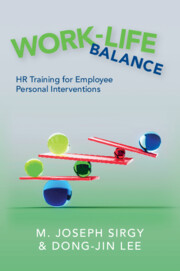Book contents
- Work-Life Balance
- Work-Life Balance
- Copyright page
- Contents
- Figures
- Tables
- Part I Making the Case for Work-Life Balance
- Part II Behavior-Based Personal Interventions of Work-Life Balance
- Chapter 4 Engaging in Multiple Roles and Domains
- Chapter 5 Increasing Role Enrichment
- Chapter 6 Engaging in Behavior-Based Compensation
- Chapter 7 Managing Role Conflict
- Chapter 8 Creating Role Balance
- Part III Cognition-Based Personal Interventions of Work-Life Balance
- Part IV Epilogue
- Index
- References
Chapter 7 - Managing Role Conflict
from Part II - Behavior-Based Personal Interventions of Work-Life Balance
Published online by Cambridge University Press: 19 January 2023
- Work-Life Balance
- Work-Life Balance
- Copyright page
- Contents
- Figures
- Tables
- Part I Making the Case for Work-Life Balance
- Part II Behavior-Based Personal Interventions of Work-Life Balance
- Chapter 4 Engaging in Multiple Roles and Domains
- Chapter 5 Increasing Role Enrichment
- Chapter 6 Engaging in Behavior-Based Compensation
- Chapter 7 Managing Role Conflict
- Chapter 8 Creating Role Balance
- Part III Cognition-Based Personal Interventions of Work-Life Balance
- Part IV Epilogue
- Index
- References
Summary
In this chapter we discuss how people try to achieve work-life balance and maintain an acceptable level of life satisfaction by reducing role conflict. Reducing role conflict is typically operationalized by (1) matching role resources with role demands, (2) managing time, and (3) managing stress. We also discuss intervention programs that organizations can use to help their employees achieve greater work-life balance through managing role conflict.
Keywords
- Type
- Chapter
- Information
- Work-Life BalanceHR Training for Employee Personal Interventions, pp. 74 - 87Publisher: Cambridge University PressPrint publication year: 2023



